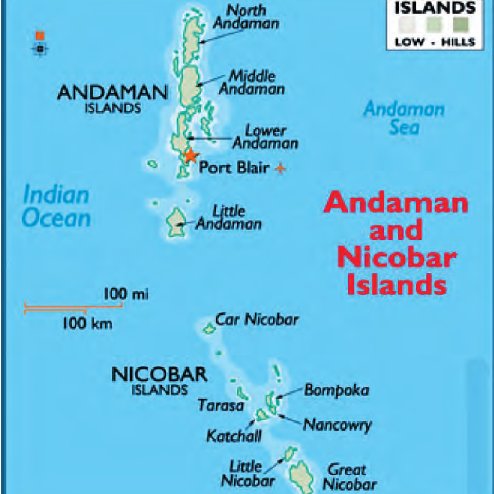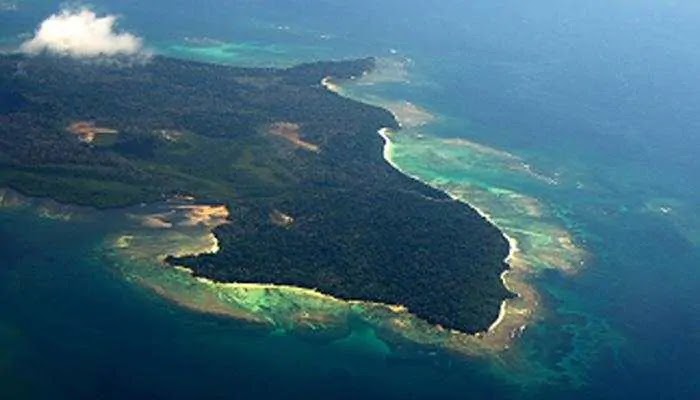About Andaman Nicobar Islands
Andaman - Nicobar Islands are unique. A paragon of beauty, these islands present a landscape of scenic and picturesque extravaganza, shimmering like emeralds in the Bay of Bengal.These emerald Islands, blessed with natural beauty, 86% forest cover, world class beaches, undulating creeks, crystal clear water and unpolluted environment command the first place to visit for tourists. This archipelago of more than 572 islets and islands with 37 inhabited islands stretches over a length of more than 700 kms, from North to South.The topography of the islands is hilly with exotic flora and fauna. The sandy beaches, fringed with coconut palms, and the sea around the islands offer excellent scope for Adventure Water Sports and game-fishing. These green islands attract many nature-lovers, and bird-watchers from all over the world. Adventure tourism like trekking, island camping, snorkeling,Sea Walk,Parasailing, scuba diving etc, are the major attractions here
Andaman - Nicobar Islands, union territory, India, consisting of two groups of islands at the southeastern edge of the Bay of Bengal. The peaks of a submerged mountain range, the Andaman Islands and their neighbors to the south, the Nicobar Islands, form an arc stretching southward for some 620 miles (1,000 km) between Myanmar (Burma) and the island of Sumatra, Indonesia. The arc constitutes the boundary between the Bay of Bengal to the west and the Andaman Sea to the east. Port Blair (on South Andaman Island) is the territorial capital.
Situated on the ancient trade route between India and Myanmar, the Andaman were visited by the navy of the English East India Company in 1789, and in 1872 they were linked administratively by the British to the Nicobar Islands. The two sets of islands became a union territory of the Republic of India in 1956. The territory has for more than a century been recognized for its indigenous communities, which have ardently avoided extensive interaction with ethnic outsiders.
In 2004 the islands drew global attention when they were severely damaged by a large tsunami that had been triggered by an earthquake in the Indian Ocean near Indonesia. Area 3,185 square miles (8,249 square km).
Andaman - Nicobar Islands - Land
The Andaman comprise more than 300 islands. North, Middle, and South Andaman, known collectively as Great Andaman, are the main islands; others include Landfall Island, Interview Island, the Sentinel Islands, Richie's Archipelago, and Rut land Island. Little Andaman in the south is separated from the Nicobar Islands by the Ten Degree Channel, which is about 90 miles (145 km) wide.
The Nicobar consist of 19 islands. Among the most prominent are Car Nicobar in the north; Camorta, Catchall, and Nancowry in the center of the chain; and Great Nicobar in the south. About 90 miles to the southwest of Great Nicobar lies the northwestern tip of Sumatra, Indonesia.
Andaman Nicobar Islands - Climate
The climate of the Andaman Nicobar Islands is tropical but is moderated by sea breezes. Temperatures typically rise from the low 70s F (about 23 °C) into the mid-80s F (about 30 °C) daily throughout the year. The territory receives roughly 120 inches (3,000 mm) of rain annually, brought mainly by the southwest monsoon, which blows from May through September, and by the tropical cyclones that follow in October and November. In the Nicobar, Great Nicobar receives considerably more rain than the other islands. The Andaman have long provided meteorological data for shipping in the Bay of Bengal; a reporting station was in operation at Port Blair as early as 1868
Andaman - Nicobar Islands - Plant and animal life
The great majority of the area of the Andaman Nicobar Islands is covered with dense tropical forest, which supports a broad spectrum of flora and fauna. The dominant tree species include narra (also called Andaman redwood, or padauk; Pterocarpus dalbergioides) and various large trees of the family Dipterocarpaceae. The harbours and tidal creeks often are surrounded by mangrove swamps. Many species of tree ferns of the family Cyatheaceae are found in the Nicobar but not in the Andaman.
The islands are inhabited by only a few dozen species of terrestrial and marine mammals, a number of which—such as the Andaman wild pig (Sus scrofa andamanensis)—are endemic to the region. Other common mammals include macaques, spotted deer, civets, shrews, whales, dolphins, and dugongs (Dugong dugon). The territory is home to more than 200 species of birds, including many endemic varieties. Numerous types of snakes and lizards inhabit the forests, and saltwater crocodiles, fish, turtles, and sea snakes are abundant in the coastal waters. Many species of flora and fauna have yet to be documented systematically.






